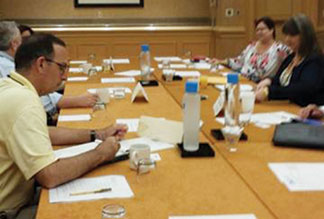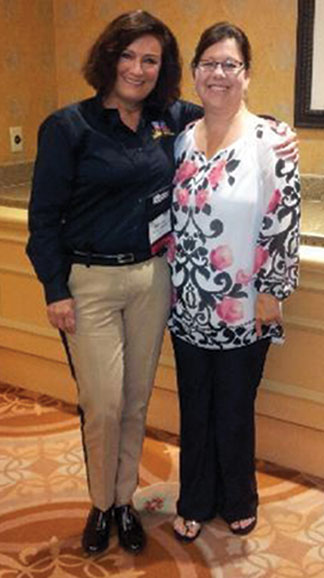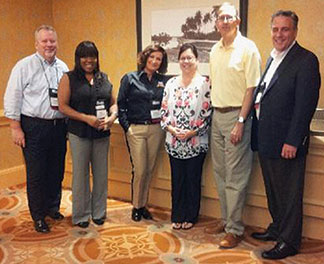

Our Roundtable Panel
- MMBB Financial Services: Jim Cook, CFP,® National Outreach Manager
- Bank of the West: Dan Mikes, Executive Vice President
- Christian Community Credit Union: Scott Reitsma, Senior Vice President, Ministry Development Group (Remote participant)
- AcctTwo: Tammy Bunting, Director of Not-for-Profit Services
- First Banks: Therese DeGroot, Managing Director, Community First Financial Resources
- Evangelical Christian Credit Union (ECCU): Randy Marsh, Ministry Development Officer
On July 15, 2014 — at the National Association of Church Business Administration (NACBA) annual conference — Church Executive hosted a live roundtable on two top-of-mind topics for church leaders: lending and finance.


Bunting, Editor RaeAnn Slaybaugh

Here, in part 1 of the conversation, a handful of executive-level experts compare the current lending climate to the Great Recession’s, as well as the effects church lending and finance is having on church staff compensation.
How does today’s church lending climate compare to the Great Recession’s?
Randy Marsh: If the Great Recession was winter, then we’re trying to find out if it’s about to become spring or if this is just a warm spell.
Therese DeGroot: There is definitely evidence that things are improving. We’re certainly seeing recovery trends in terms of tithes / offerings and attendance, which results in more lending opportunities. We analyze the trends in our entire portfolio quarterly, as well as annually, and what we noticed during this recent recessionary cycle was somewhat different from previous cycles in that we did not see attendance increase as much and saw that giving was more flat instead of declining, unless some major event occurred.
Dan Mikes: I would say churches’ borrowing capacity is lower than it was going into the Great Recession. Pre-downturn, there were some aggressive income-to-debt levels which banks were a little more comfortable with than they are these days.
As far as lenders and their availability, I don’t see any downward tick at all. Our closing ratios haven’t changed, really; I don’t see indications that there’s less competition.
We close about one-third of the deals we put on the table.
Another observation is that the loan-to-value situation in certain areas has been strained; real estate values took a deep dive and haven’t recovered quite enough. Or, there have been a number of distressed church sales that weigh in against the comparable sales, which appraisers cite.
Therese DeGroot: I agree that the loan-to-value situation has been a driver in ability to refinance loans. We have always been a conservative lender who encourages capital campaigns. Painful as it can be to raise money for debt reduction, sometimes that’s the best all-around way to reduce debt and align it more with the overall budget, which will also address the loan-to-value issue.
Randy Marsh: Also, a lot of churches are finding that their loan-to-value ratios put them in a difficult position for a rollover.
Scott Reitsma: There has been a significant shift in regulatory oversight of financial institutions, which affects lending to churches. As lenders, the numbers are important to us; but, we’re now requiring due diligence into polity, organizational and decision-making structure, leaders’ financial acumen, denominational support and so on.

What effects is church lending / finance having on compensation and benefits for church staff?
Scott Reitsma: Churches adjusted accordingly to survive (or thrive) during the Great Recession. We saw reduced full-time equivalents on staff. We also saw reduced program offerings, salary and benefits in an attempt to balance budgets. Today, however, a major survey shows marginal increases in church staff salaries.
Randy Marsh: Personnel and debt service are a church’s two biggest expenses, and one drives the other. If you’re carrying a lot of debt, you have to run lean — either on the number of staff you have or what you pay them. So, churches are making some decisions there, especially if they have a lot of staff and a minister for everything.
Jim Cook: Broadly, there was some pullback during the recession. Raises weren’t necessarily being given. Some trending we saw in churches surrounded consolidation of staff — some layoffs and some folks retiring and not being replaced.
Right now, I think the market is competitive for benefits. We’re seeing requests for proposal (RFPs); churches are taking a real serious approach.
Therese DeGroot: In nonprofits — churches being one of the primary segments — pay is comparatively low. So, the competition for people who have experience in management and business is head to head with the secular world. It’s a tough job working for a church because you work harder and more hours at a church. In down times, it’s really difficult for churches to compensate and keep delivering to staff at least a cost-of-living increase.
Tammy Bunting: There’s some energy happening around this issue right now, with compensation surveys. We have an an HR group that’s comparing things like compensation percentiles. We’re finding that the one thing churches are doing is offering competitive benefits, which is critical — especially with the healthcare changes.
Churches are becoming more and more mega. So, there’s more competition for talent.
Jim Cook: To add to what Therese and Tammy just said, when I talk to church administrators — particularly at larger churches — there’s definitely recognition that they’re in competition with the marketplace for non-ministry staff. While there are still some churches that are more slow to acknowledge that, most understand that if they need somebody who knows finance, they’re competing with all the businesses down the street.
The smart administrators I’m talking to are saying the same thing: Benefits make a difference.
— Reporting by RaeAnn Slaybaugh
Keep an eye out for part 2!
This insightful discussion continues in our Nov / Dec 2014 issue. Panelists will delve into:
- How the lending climate has changed in the past year
- Their forecasts for one year from now
- The practical steps can a church take to secure a loan
They’ll also offer more analysis about how church lending and finance is affecting compensation for church employees.


